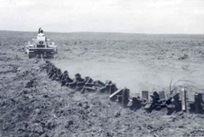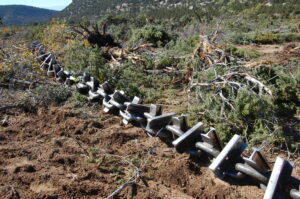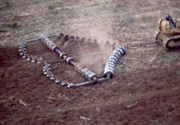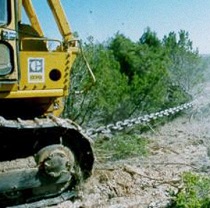Description
Modified chains are anchor chains with material added to the chain links for the purpose of increasing soil disturbance. Railroad rails, rods, blades, or disks have been used. A modification known as an “Ely Chain” uses 18 inch pieces of railroad rail (70 to 90 lb/yard) welded to each or every other chain link. A chain with disk blades welded to every other chain link is known as a “disk chain.” The optimum blade diameter is 28 inches. Diking chains use blades (12 x 4 inches) welded to opposite sides of every chain link to form small basins in the soil as the chain rotates. The combination of the disk and diking chain is called a disk-chain-diker. A unit with 20 disk blades is 35-feet wide and requires a 165- to 200-horsepower crawler tractor to pull it.
Application
Modified chains must rotate to achieve the desired results. Swivels fabricated in welding shops or modified from track rollers are attached to each end of the chain to allow chain rotation. Railroad-rail chains are towed in a “J” shape rather than a “U” to achieve maximum soil disturbance. Disk chains are towed on a diagonal to achieve optimum disking action. This type chain was developed to achieve tillage on debris- and shrub-littered rangelands at chaining costs. As the diking chain rolls, diamond shaped basins 4-inches deep are formed at the rate of 18,000/acre to collect rainfall. The combination of disking and diking chains enhances seedbed preparation and provides limited shrub control. Seedbeds prepared with the disk-chain-diker have produced grass densities double those in seedbeds prepared by standard chaining, and the disk-chain-diker method is cost and energy effective. More information on these chains is available in the Anchor Chains and Modified Chains sections of the Mechanical Control chapter.
Used anchor chain and accessories can be purchased from marine supply or salvage companies located in coastal cities of the United States. Used railroad rails can be purchased from local train companies. Disk blades can be purchased from local tractor dealers. Local fabrication shops can modify the chains.
Images
References / Additional Information
Cain, D. 1971. The Ely Chain. 1972 Proceedings of the Cal-Neva Wildlife Transactions: 82-86.
Stevens, R.; Monsen, S.B. 2004. Chapter 9. Mechanical plant control. In: Monsen, S.B.; Stevens, R.; Shaw, N.L., comps. Restoring western ranges and wildlands, vol. 1. Gen. Tech. Rep. RMRS-GTR-136-vol-1. Fort Collins, CO: U.S. Department of Agriculture, Forest Service, Rocky Mountain Research Station. p. 65-88.
Wiedemann, H.T. 2007. Sculpting brush mechanically: Current state of the art. Rangelands. 29(5): 10-17.






